
- SAP Community
- Products and Technology
- Technology
- Technology Blogs by Members
- Simplify User Administration in SAP Analytics Clou...
Technology Blogs by Members
Explore a vibrant mix of technical expertise, industry insights, and tech buzz in member blogs covering SAP products, technology, and events. Get in the mix!
Turn on suggestions
Auto-suggest helps you quickly narrow down your search results by suggesting possible matches as you type.
Showing results for
mfoeken
Active Contributor
Options
- Subscribe to RSS Feed
- Mark as New
- Mark as Read
- Bookmark
- Subscribe
- Printer Friendly Page
- Report Inappropriate Content
11-04-2019
9:05 AM
SAP Analytics Cloud is positioned by SAP as the strategic cloud-based solution for all analytics. In the coming years, an increasing number of customers will start, or extend, their cloud investments and shift from existing on-premise BI solutions to SAP Analytics Cloud to connect people, information and ideas to enable fast and confident decision making. To support this shift, it’s crucial that SAP offers capabilities to seamlessly integrate with other components in the IT landscape, especially for authentication and authorization to minimize support effort required.
In this blog series I will show you how you can simplify the user administration in SAP Analytics Cloud and minimize the effort required by ensuring that a user profile gets dynamically created with single sign-on access to the SAP Analytics Cloud tenant along with automatic assignment of the user’s properties, required role(s) and team(s) based on SAML attributes.
For a user to be able to access SAP Analytics Cloud, there is basically one prerequisite: a user profile needs to exist. With this user profile in SAP Analytics Cloud, a user can successfully login by providing an email address and a password (by default stored in SAP Cloud Identity).
SAP Analytics Cloud supports multiple ways to create (and maintain) user profiles:
Given the fact that we are aiming to minimize the effort required for user administration, the latter option, dynamic user creation, sounds like the way to go! This option means that a user profile is automatically created when a user accesses the SAP Analytics Cloud tenant. Let’s see what you need to do to enable dynamic user creation in SAP Analytics Cloud.
The option to dynamically create users is part of enabling single sign-on on the SAP Analytics Cloud tenant. A benefit of enabling single sign-on is that users don’t have to authenticate by typing in an email address and password. A prerequisite is that the user must have a corresponding user profile in the Identify Provider (IdP).
SAP Analytics Cloud supports configuring single sign-on authentication based on an IdP that supports SAML 2.0. In our example, we are using Azure Active Directory (AD). If you want more information on how the single sign-on SAML protocol is supported in Azure AD, please read the following article: Single Sign-On SAML protocol.
Before we can enable single sign-on in the SAP Analytics Cloud tenant we have to create an application in Azure AD. Integrating SAP Analytics Cloud with Azure AD provides you with the following benefits:
To create the Azure AD application, metadata from the SAP Analytics Cloud tenant is required. Make sure you perform the following steps to collect the metadata:

If necessary, you can assign the ‘System_Owner’ role to a different user via ‘Menu’ – ‘Security’ – ‘Users’. Select a user and click on ‘Assign as System Owner’.



Now that we have collected the metadata from our SAP Analytics Cloud tenant, we can create an application in Azure AD:

Next step is to setup Single sign-on using SAML.
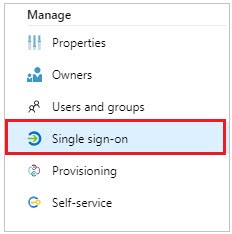



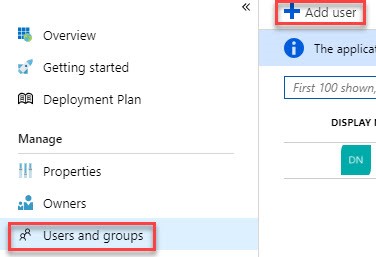
Now that we configured the application in Azure AD, let’s start with enabling SAML single sign-on in our SAP Analytics Cloud tenant.



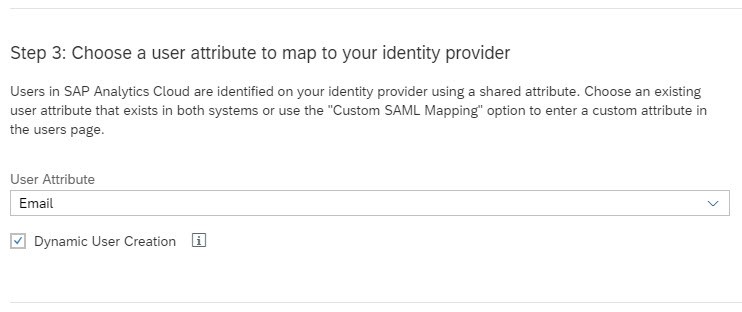
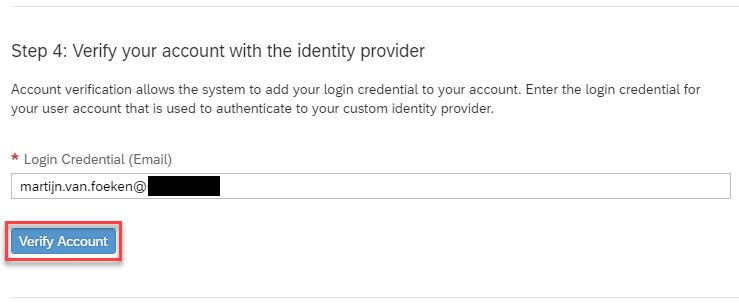




Ok, great! We have now successfully enabled SAML single sign-on on the SAP Analytics Cloud tenant.
Now let’s see what happens when a user that doesn’t have a user account browses to the SAP Analytics Cloud tenant URL.
Ask one of your users to browse to the SAP Analytics Cloud tenant and validate if the user gets single sign-on access. Please ensure that the user is added to the AD group that has been granted access to the Azure AD application we created.
Once the login is successful you can see that the user is not capable of doing much. This is due to the lack of assigned roles and teams. But before we look at how to automatically assign those, we first want to use SAML to map the user properties maintained in the IdP.

The benefit of mapping SAML User properties is that the user profile in SAP Analytics Cloud is updated with the latest information from your SAML IdP. Each time a user logs on to SAP Analytics Cloud, the latest information will be read and updated in their SAP Analytics Cloud user profile.
Using SAML attributes to map to user properties is not enabled by default. Enabling SAML attributes must be requested by creating an SAP support ticket using the component LOD-ANA-BI. Please include your tenant URL. SAP support will take care of the request and will confirm in the ticket when the necessary steps are executed.
Another prerequisite for mapping user properties to SAML attributes is that the correct SAML attributes are exposed by the application in Azure. Furthermore, we need to change the ‘namespace’ value to a blank (or something else), otherwise, SAP Analytics Cloud will not allow mapping because the default namespace contains special characters.
Please follow the next steps:


If your SAP Analytics Cloud tenant is running in a non-SAP data center you must configure your SAML IdP to map user attributes to the following case-sensitive white-listed assertion attributes:

Make sure you add the attribute 'Groups' with a value of "sac" as displayed above. This is mandatory to make sure that the custom1, custom2, etc. attributes become visible in SAP Analytics Cloud when performing a SAML mapping.

If you are using the SAP Cloud Platform Identity Authentication service as your IdP, map the Groups attribute under Default Attributes for your SAP Analytics Cloud application. The remaining attributes should be mapped under Assertion Attributes for your SAP Analytics Cloud application.
More information can be found here: Enabling a Custom SAML Identity Provider.
Now that all the SAML attributes are configured properly let’s set up the mapping of SAML User properties:


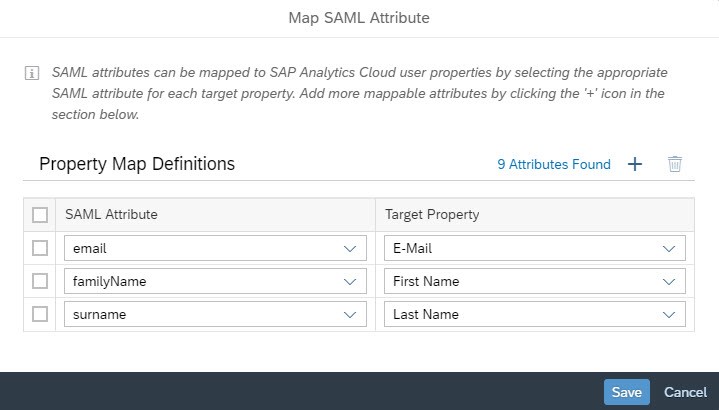

So far, we managed to enable single sign-on to the SAP Analytics Cloud tenant including dynamic user creation and we mapped the user properties to SAML attributes maintained in our IdP, so we already reduced the support effort required and simplified user administration in SAP Analytics Cloud. But the annoying thing is that these dynamically created users are not able to do much, yet!
The permissions to perform certain actions, like viewing or creating stories are maintained via ‘Roles’. Based on your license, SAP Analytics Cloud comes with several pre-defined roles for BI, Planning, Predictive, etc. Below an example of the permissions for the standard ‘BI Content Viewer’ role is displayed.

The great thing about SAP Analytics Cloud is that we can automatically map roles to users based on SAML attributes. This means that when a user is dynamically created, one or multiple roles will be assigned based on a specific value in one of the SAML attributes.
In our example, we want to use the Group claim that contains the values of the security groups but before this is available as part of the SAML assertion we first need to edit the manifest of the application:
To be able to use security groups as a SAML attribute, we need to edit the application manifest in Azure AD. Please follow the next steps:

To ensure the Group claim can be properly consumed by SAP Analytics Cloud, the namespace can’t contain any special characters. By default, the namespace of a SAML attribute is used for the mapping instead of the name of the attribute. To avoid issue we need to make sure the namespace is blank.


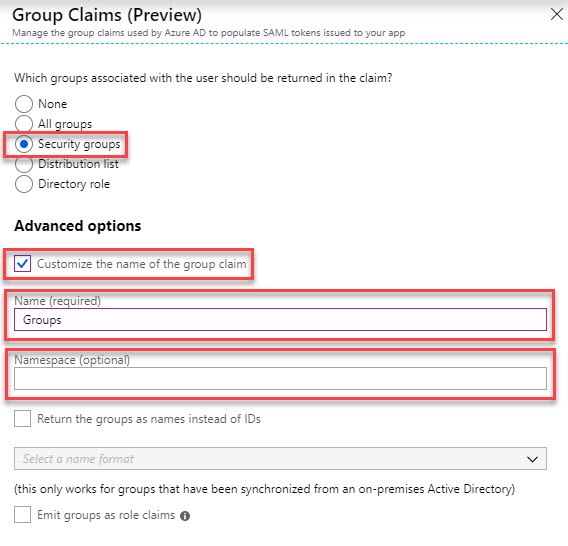
Let’s share how you can setup you SAP Analytics Cloud tenant to use the Group claim as SAML attribute to automatically assign users to a role:



Each time a user accesses the SAP Analytics Cloud tenant the role(s) assigned to the user will be updated based on the values in the SAML Token.
The final step is granting users access to stories and applications within the SAP Analytics Cloud tenant. This is managed via the sharing permissions that can be set via ‘Menu’ – ‘Browse’ – ‘Folders’. For each folder and file, you can define the ‘Sharing Settings’ based on users and/or teams. The sharing settings define if a user has access to a certain object or folder and which actions the user can perform.
Users can be grouped into teams and can be a member of zero, one or multiple teams. By using teams in applying sharing settings we can create an authorization model in SAP Analytics Cloud. Let’s look at how we can automate team assignments, like assigning roles using SAML attributes.

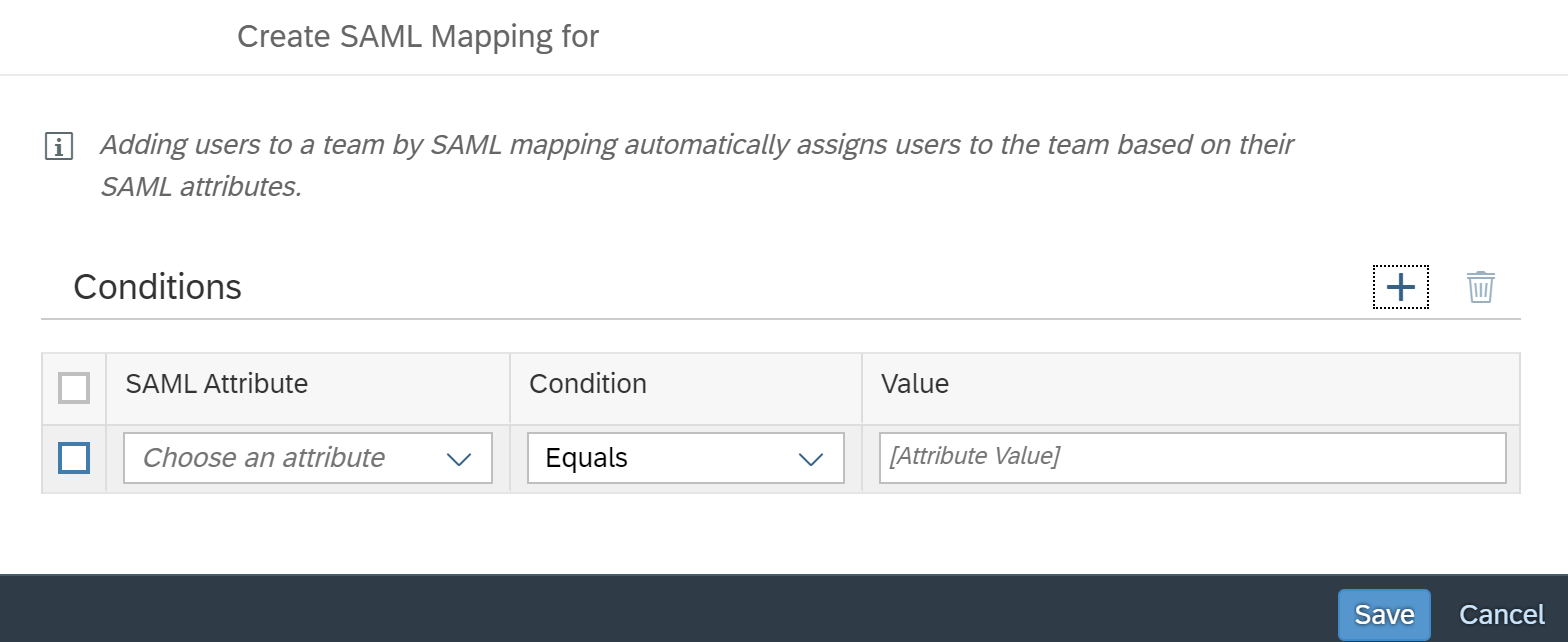
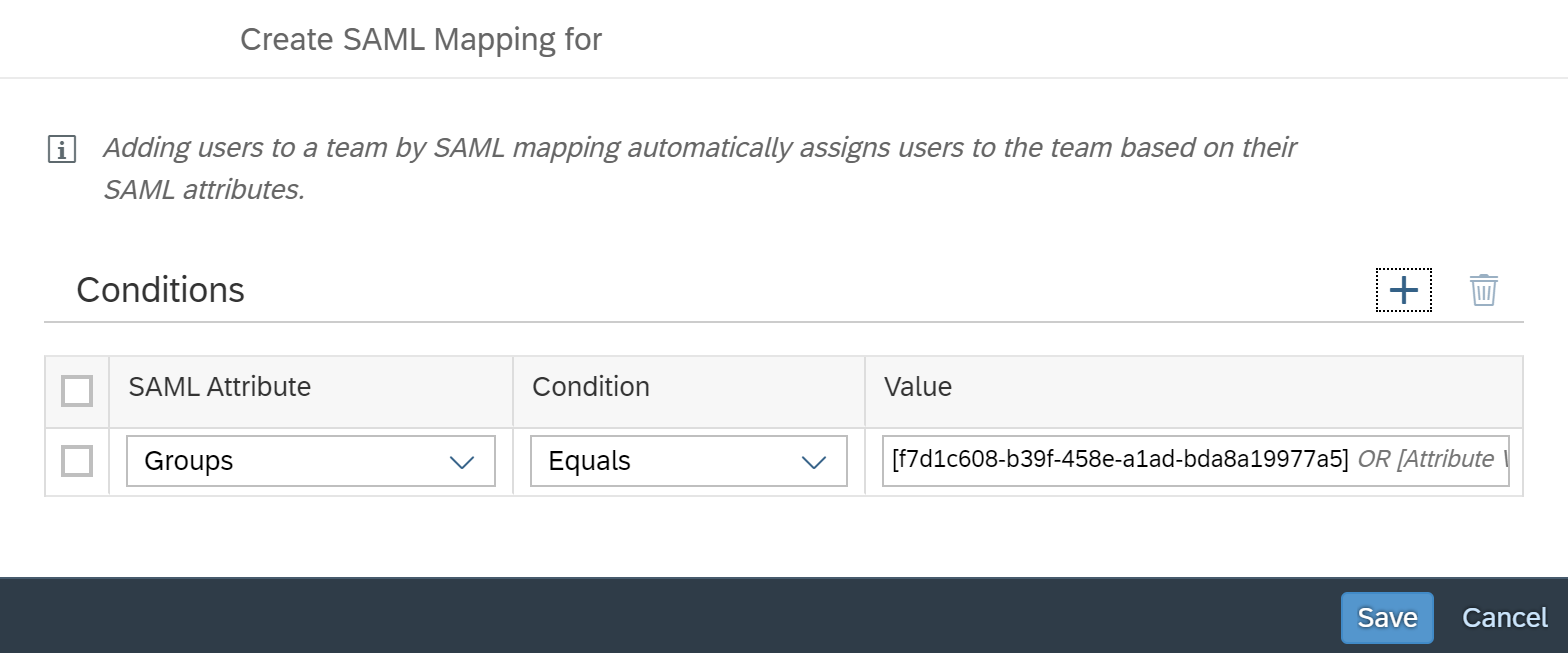

By enabling SSO to you SAP Analytics Cloud tenant, map the user properties and map teams and roles based on group membership administrated in your custom IdP you can reduce the efforts around user administration. This is an important step for further adaptation of Cloud-based solutions in your IT landscape.
In this blog series I will show you how you can simplify the user administration in SAP Analytics Cloud and minimize the effort required by ensuring that a user profile gets dynamically created with single sign-on access to the SAP Analytics Cloud tenant along with automatic assignment of the user’s properties, required role(s) and team(s) based on SAML attributes.
Manage Users: Setup Dynamic User Creation via Single Sign-On
For a user to be able to access SAP Analytics Cloud, there is basically one prerequisite: a user profile needs to exist. With this user profile in SAP Analytics Cloud, a user can successfully login by providing an email address and a password (by default stored in SAP Cloud Identity).
SAP Analytics Cloud supports multiple ways to create (and maintain) user profiles:
- Manually;
- Import from a file;
- Import from Active Directory;
- Dynamic user creation.
Given the fact that we are aiming to minimize the effort required for user administration, the latter option, dynamic user creation, sounds like the way to go! This option means that a user profile is automatically created when a user accesses the SAP Analytics Cloud tenant. Let’s see what you need to do to enable dynamic user creation in SAP Analytics Cloud.
In this example we are using an SAP Analytics Cloud tenant in an SAP data center, also referred to as an NEO tenant. You can determine where your tenant is hosted by inspecting the SAP Analytics Cloud tenant URL:
|
Setup Single Sign-On
The option to dynamically create users is part of enabling single sign-on on the SAP Analytics Cloud tenant. A benefit of enabling single sign-on is that users don’t have to authenticate by typing in an email address and password. A prerequisite is that the user must have a corresponding user profile in the Identify Provider (IdP).
SAP Analytics Cloud supports configuring single sign-on authentication based on an IdP that supports SAML 2.0. In our example, we are using Azure Active Directory (AD). If you want more information on how the single sign-on SAML protocol is supported in Azure AD, please read the following article: Single Sign-On SAML protocol.
Set up an Application in Azure
Before we can enable single sign-on in the SAP Analytics Cloud tenant we have to create an application in Azure AD. Integrating SAP Analytics Cloud with Azure AD provides you with the following benefits:
- You can control in Azure AD who has access to SAP Analytics Cloud.
- You can enable your users to be automatically signed-in to SAP Analytics Cloud (Single Sign-On) with their Azure AD accounts.
- You can manage your accounts in one central location - the Azure portal.
Collect SAP Analytics Cloud Metadata
To create the Azure AD application, metadata from the SAP Analytics Cloud tenant is required. Make sure you perform the following steps to collect the metadata:
- Browse to the SAP Analytics Cloud tenant and log in with the user that has the ‘System_Owner’ role. This is a prerequisite to perform the necessary configuration steps to collect the metadata. Without the ‘System_Owner’ role, you are not allowed to change the ‘Authentication Method’.

If necessary, you can assign the ‘System_Owner’ role to a different user via ‘Menu’ – ‘Security’ – ‘Users’. Select a user and click on ‘Assign as System Owner’.
- Access the Security menu via ‘Menu’ – ‘System’ – ‘Administration’ – ‘Security’. Click on ‘Edit’ in the upper-right corner to make changes to the configuration.

- Switch the ‘Authentication Method’ from ‘SAP Cloud Identity (default)’ to ‘SAML Single Sign-On (SSO)’.

- Click on ‘Download’ and open the XML file.

- Copy and paste the following values from the XML file:
- entityID: [tenant].[location].sapanalytics.cloud. This will be used as ‘Identifier’.
- SingleSignOnService Binding location: https://authn.[location].hana.ondemand.com/saml2/sp/acs/[subaccount]/[subaccount]. This needs to be filled in later on as ‘Reply URL’.
- Click on the ‘Cancel’ icon to discard the current changes and revert to ‘SAP Cloud Identity’ authentication for now.
Create an Application in Azure
Now that we have collected the metadata from our SAP Analytics Cloud tenant, we can create an application in Azure AD:
- Browse to your Azure portal and in the left navigation panel, click on ‘Azure Active Directory’.

- Navigate to ‘Enterprise Applications’ and then select the ‘All applications’ option.
- To add a new application, click the ‘New application’ button on the top of the dialog.
- Create a custom application and enter a name. In our example, we will use ‘SAP Analytics Cloud Trial’.
Next step is to setup Single sign-on using SAML.
- Select ‘Single sign-on’.

- Click on the ‘Edit’ icon to set up the ‘Basic SAML Configuration’.

- Enter the ‘Identifier’ and the ‘Reply URL’ collected from the XML file of the SAP Analytics Cloud tenant and click ‘Save’. Another option is to upload the metadata file to auto-populate these fields.

- The next step is to save the download the ‘Federation Metadata XML’ file. We need this file to enable the application to act as IdP in SAP Analytics Cloud.

- The final step is to grant access to the application we just created in Azure. Please go to ‘Users and groups’ and click on ‘Add User’.

- Because we want to enable dynamic user creation a group should be added that contains all target users within your organization which should be allowed to use SAP Analytics Cloud.
Enabling a Custom SAML Identity Provider
Now that we configured the application in Azure AD, let’s start with enabling SAML single sign-on in our SAP Analytics Cloud tenant.
- Access the Security menu via ‘Menu’ – ‘System’ – ‘Administration’ – ‘Security’. Click on ‘Edit’ in the upper-right corner to make changes to the configuration.

- Switch the ‘Authentication Method’ from ‘SAP Cloud Identity (default)’ to ‘SAML Single Sign-On (SSO)’.

- Click on ‘Upload’ to upload the metadata.xml file of our Azure AD application and click ‘OK’.

- In Step 3 select the user attribute to map to our IdP. Select ‘Email’ and check the box to enable ‘Dynamic User Creation’.

- In Step 4 we are verifying our account against Azure AD. Provide the ‘Login Credential’ and click on ‘Verify Account’.

- A ‘Login URL’ is displayed. Use the ‘Copy’ icon to select and copy the URL and paste it into a private browser session (incognito mode).

- Once the private browser session displays the message below, the SAML account has been verified successfully.

- Click ‘Save’ to save the configuration changes.

- Click ‘Convert’ to change the authentication method to SAML single sign-on.

Ok, great! We have now successfully enabled SAML single sign-on on the SAP Analytics Cloud tenant.
Now let’s see what happens when a user that doesn’t have a user account browses to the SAP Analytics Cloud tenant URL.
Validate Dynamic User Creation
Ask one of your users to browse to the SAP Analytics Cloud tenant and validate if the user gets single sign-on access. Please ensure that the user is added to the AD group that has been granted access to the Azure AD application we created.
Once the login is successful you can see that the user is not capable of doing much. This is due to the lack of assigned roles and teams. But before we look at how to automatically assign those, we first want to use SAML to map the user properties maintained in the IdP.

Map SAML User Properties
The benefit of mapping SAML User properties is that the user profile in SAP Analytics Cloud is updated with the latest information from your SAML IdP. Each time a user logs on to SAP Analytics Cloud, the latest information will be read and updated in their SAP Analytics Cloud user profile.
Submit a Support Ticket
Using SAML attributes to map to user properties is not enabled by default. Enabling SAML attributes must be requested by creating an SAP support ticket using the component LOD-ANA-BI. Please include your tenant URL. SAP support will take care of the request and will confirm in the ticket when the necessary steps are executed.
User Attributes in Azure
Another prerequisite for mapping user properties to SAML attributes is that the correct SAML attributes are exposed by the application in Azure. Furthermore, we need to change the ‘namespace’ value to a blank (or something else), otherwise, SAP Analytics Cloud will not allow mapping because the default namespace contains special characters.
Please follow the next steps:
- Browse to the Azure portal and click on ‘Enterprise applications’ – ‘All applications’.
- Select ‘Single sign-on’ and click on the ‘Edit’ icon for the ‘User Attributes & Claims’ section.

- Add a new claim or change an existing one based on your requirements and set up in Azure AD. At least make sure that the namespace for each attribute you wish to expose is blank or at least doesn’t contain any special characters.

- Click ‘Save’.
If your SAP Analytics Cloud tenant is running in a non-SAP data center you must configure your SAML IdP to map user attributes to the following case-sensitive white-listed assertion attributes:

Make sure you add the attribute 'Groups' with a value of "sac" as displayed above. This is mandatory to make sure that the custom1, custom2, etc. attributes become visible in SAP Analytics Cloud when performing a SAML mapping.

If you are using the SAP Cloud Platform Identity Authentication service as your IdP, map the Groups attribute under Default Attributes for your SAP Analytics Cloud application. The remaining attributes should be mapped under Assertion Attributes for your SAP Analytics Cloud application.
More information can be found here: Enabling a Custom SAML Identity Provider.
Map SAML Attributes
Now that all the SAML attributes are configured properly let’s set up the mapping of SAML User properties:
- Access the ‘Users’ menu via ‘Menu’ – ‘Security’ – ‘Users’. Click on ‘Map SAML User Properties’ in the upper-right corner to make changes to the configuration.

- The ‘Map SAML Attribute’ dialog will display. Here we define which ‘SAML Attribute’ is mapped to which ‘Target Property’.

- Select the ‘SAML Attribute’ for each ‘Target Property’ and click ‘Save’. If you want to add additional mappings use the ‘New mapping definition’ icon.

- Click on ‘Save’.
- As displayed below the user properties in your SAP Analytics Cloud tenant are read from the linked Identity Provider each time a user logs in.

Mapping Role(s) using SAML Attributes
So far, we managed to enable single sign-on to the SAP Analytics Cloud tenant including dynamic user creation and we mapped the user properties to SAML attributes maintained in our IdP, so we already reduced the support effort required and simplified user administration in SAP Analytics Cloud. But the annoying thing is that these dynamically created users are not able to do much, yet!
The permissions to perform certain actions, like viewing or creating stories are maintained via ‘Roles’. Based on your license, SAP Analytics Cloud comes with several pre-defined roles for BI, Planning, Predictive, etc. Below an example of the permissions for the standard ‘BI Content Viewer’ role is displayed.

The great thing about SAP Analytics Cloud is that we can automatically map roles to users based on SAML attributes. This means that when a user is dynamically created, one or multiple roles will be assigned based on a specific value in one of the SAML attributes.
In our example, we want to use the Group claim that contains the values of the security groups but before this is available as part of the SAML assertion we first need to edit the manifest of the application:
Edit Manifest
To be able to use security groups as a SAML attribute, we need to edit the application manifest in Azure AD. Please follow the next steps:
- Select ‘Azure Active Directory’ in the Azure Portal, and then select ‘App registrations.
- Select the application we just configured from the list of applications.
- From the app’s overview page select ‘Manifest’. A web-based manifest editor opens, allowing you to edit the manifest within the portal. Optionally, you can select Download to edit the manifest locally, and then use Upload to reapply it to your application. Change the value of the “groupMembershipClaims” from ‘null’ to “SecurityGroup” and click on ‘Save’.

To ensure the Group claim can be properly consumed by SAP Analytics Cloud, the namespace can’t contain any special characters. By default, the namespace of a SAML attribute is used for the mapping instead of the name of the attribute. To avoid issue we need to make sure the namespace is blank.
- Browse to ‘Enterprise Applications’ and select our application.
- Click on ‘Single sign-on’ and select ‘Edit’ for the ‘User Attributes & Claims’ section.

- Click on ‘Edit’ for ‘Groups returned in claim’.

- Select ‘Security groups’ and tick the checkbox that allows customization of the ‘Name’ and the ‘Namespace’. Enter a name for the claim, in our example ‘Groups’.

- Click on ‘Save’.
Configure Role Mapping
Let’s share how you can setup you SAP Analytics Cloud tenant to use the Group claim as SAML attribute to automatically assign users to a role:
- Go to ‘Roles’ via ‘Main Menu’ – ‘Security’ – ‘Roles’. Click on the Role that needs to be mapped to a SAML attribute value.
- Click on the ‘Open SAML Role Mapping’ icon.

- In this dialog, we can specify based on which value of a SAML attribute the role should be assigned to a user in SAP Analytics Cloud.

- Select one of the attributes which are available for mapping from the drop-down menu ‘SAML Attribute’. The list of attributes displayed match the ‘SAML Token Attributes’ which are part of our Azure AD application. In our example, we are using an attribute called ‘Groups’ which exposes the values of the ID of the Azure groups a user is a member of. This has been enabled earlier by editing the manifest to issue the group claim.

- Click on ‘Save’.
Each time a user accesses the SAP Analytics Cloud tenant the role(s) assigned to the user will be updated based on the values in the SAML Token.
Mapping Team(s) using SAML attributes
The final step is granting users access to stories and applications within the SAP Analytics Cloud tenant. This is managed via the sharing permissions that can be set via ‘Menu’ – ‘Browse’ – ‘Folders’. For each folder and file, you can define the ‘Sharing Settings’ based on users and/or teams. The sharing settings define if a user has access to a certain object or folder and which actions the user can perform.
Users can be grouped into teams and can be a member of zero, one or multiple teams. By using teams in applying sharing settings we can create an authorization model in SAP Analytics Cloud. Let’s look at how we can automate team assignments, like assigning roles using SAML attributes.
- Go to the ‘Menu’ – ‘Security’ – ‘Teams’.
- Click on the checkbox in front of the team and click on the ‘Open SAML Team Mapping’ icon.

- In this dialog, we can specify based on which value of a SAML attribute the team should be assigned to a user in SAP Analytics Cloud.

- Select one of the attributes which are available for mapping from the drop-down menu ‘SAML Attribute’. The list of attributes displayed match the ‘SAML Token Attributes’ which are part of our Azure AD application. In our example, we are using an attribute called ‘Groups’ which exposes the values of the ID of the Azure groups a user is a member of. This has been enabled earlier by editing the manifest to issue the group claim.

- Click Save.

- The mapping is finalized. When a user will log in to the tenant team membership will be assigned based on values in the SAML Token.
Summary
By enabling SSO to you SAP Analytics Cloud tenant, map the user properties and map teams and roles based on group membership administrated in your custom IdP you can reduce the efforts around user administration. This is an important step for further adaptation of Cloud-based solutions in your IT landscape.
- SAP Managed Tags:
- SAP Analytics Cloud
36 Comments
You must be a registered user to add a comment. If you've already registered, sign in. Otherwise, register and sign in.
Labels in this area
-
"automatische backups"
1 -
"regelmäßige sicherung"
1 -
"TypeScript" "Development" "FeedBack"
1 -
505 Technology Updates 53
1 -
ABAP
14 -
ABAP API
1 -
ABAP CDS Views
2 -
ABAP CDS Views - BW Extraction
1 -
ABAP CDS Views - CDC (Change Data Capture)
1 -
ABAP class
2 -
ABAP Cloud
2 -
ABAP Development
5 -
ABAP in Eclipse
1 -
ABAP Platform Trial
1 -
ABAP Programming
2 -
abap technical
1 -
absl
2 -
access data from SAP Datasphere directly from Snowflake
1 -
Access data from SAP datasphere to Qliksense
1 -
Accrual
1 -
action
1 -
adapter modules
1 -
Addon
1 -
Adobe Document Services
1 -
ADS
1 -
ADS Config
1 -
ADS with ABAP
1 -
ADS with Java
1 -
ADT
2 -
Advance Shipping and Receiving
1 -
Advanced Event Mesh
3 -
AEM
1 -
AI
7 -
AI Launchpad
1 -
AI Projects
1 -
AIML
9 -
Alert in Sap analytical cloud
1 -
Amazon S3
1 -
Analytical Dataset
1 -
Analytical Model
1 -
Analytics
1 -
Analyze Workload Data
1 -
annotations
1 -
API
1 -
API and Integration
3 -
API Call
2 -
Application Architecture
1 -
Application Development
5 -
Application Development for SAP HANA Cloud
3 -
Applications and Business Processes (AP)
1 -
Artificial Intelligence
1 -
Artificial Intelligence (AI)
5 -
Artificial Intelligence (AI) 1 Business Trends 363 Business Trends 8 Digital Transformation with Cloud ERP (DT) 1 Event Information 462 Event Information 15 Expert Insights 114 Expert Insights 76 Life at SAP 418 Life at SAP 1 Product Updates 4
1 -
Artificial Intelligence (AI) blockchain Data & Analytics
1 -
Artificial Intelligence (AI) blockchain Data & Analytics Intelligent Enterprise
1 -
Artificial Intelligence (AI) blockchain Data & Analytics Intelligent Enterprise Oil Gas IoT Exploration Production
1 -
Artificial Intelligence (AI) blockchain Data & Analytics Intelligent Enterprise sustainability responsibility esg social compliance cybersecurity risk
1 -
ASE
1 -
ASR
2 -
ASUG
1 -
Attachments
1 -
Authorisations
1 -
Automating Processes
1 -
Automation
2 -
aws
2 -
Azure
1 -
Azure AI Studio
1 -
B2B Integration
1 -
Backorder Processing
1 -
Backup
1 -
Backup and Recovery
1 -
Backup schedule
1 -
BADI_MATERIAL_CHECK error message
1 -
Bank
1 -
BAS
1 -
basis
2 -
Basis Monitoring & Tcodes with Key notes
2 -
Batch Management
1 -
BDC
1 -
Best Practice
1 -
bitcoin
1 -
Blockchain
3 -
bodl
1 -
BOP in aATP
1 -
BOP Segments
1 -
BOP Strategies
1 -
BOP Variant
1 -
BPC
1 -
BPC LIVE
1 -
BTP
12 -
BTP Destination
2 -
Business AI
1 -
Business and IT Integration
1 -
Business application stu
1 -
Business Application Studio
1 -
Business Architecture
1 -
Business Communication Services
1 -
Business Continuity
1 -
Business Data Fabric
3 -
Business Partner
12 -
Business Partner Master Data
10 -
Business Technology Platform
2 -
Business Trends
4 -
CA
1 -
calculation view
1 -
CAP
3 -
Capgemini
1 -
CAPM
1 -
Catalyst for Efficiency: Revolutionizing SAP Integration Suite with Artificial Intelligence (AI) and
1 -
CCMS
2 -
CDQ
12 -
CDS
2 -
Cental Finance
1 -
Certificates
1 -
CFL
1 -
Change Management
1 -
chatbot
1 -
chatgpt
3 -
CL_SALV_TABLE
2 -
Class Runner
1 -
Classrunner
1 -
Cloud ALM Monitoring
1 -
Cloud ALM Operations
1 -
cloud connector
1 -
Cloud Extensibility
1 -
Cloud Foundry
4 -
Cloud Integration
6 -
Cloud Platform Integration
2 -
cloudalm
1 -
communication
1 -
Compensation Information Management
1 -
Compensation Management
1 -
Compliance
1 -
Compound Employee API
1 -
Configuration
1 -
Connectors
1 -
Consolidation Extension for SAP Analytics Cloud
2 -
Control Indicators.
1 -
Controller-Service-Repository pattern
1 -
Conversion
1 -
Cosine similarity
1 -
cryptocurrency
1 -
CSI
1 -
ctms
1 -
Custom chatbot
3 -
Custom Destination Service
1 -
custom fields
1 -
Customer Experience
1 -
Customer Journey
1 -
Customizing
1 -
cyber security
3 -
Data
1 -
Data & Analytics
1 -
Data Aging
1 -
Data Analytics
2 -
Data and Analytics (DA)
1 -
Data Archiving
1 -
Data Back-up
1 -
Data Governance
5 -
Data Integration
2 -
Data Quality
12 -
Data Quality Management
12 -
Data Synchronization
1 -
data transfer
1 -
Data Unleashed
1 -
Data Value
8 -
database tables
1 -
Datasphere
2 -
datenbanksicherung
1 -
dba cockpit
1 -
dbacockpit
1 -
Debugging
2 -
Delimiting Pay Components
1 -
Delta Integrations
1 -
Destination
3 -
Destination Service
1 -
Developer extensibility
1 -
Developing with SAP Integration Suite
1 -
Devops
1 -
digital transformation
1 -
Documentation
1 -
Dot Product
1 -
DQM
1 -
dump database
1 -
dump transaction
1 -
e-Invoice
1 -
E4H Conversion
1 -
Eclipse ADT ABAP Development Tools
2 -
edoc
1 -
edocument
1 -
ELA
1 -
Embedded Consolidation
1 -
Embedding
1 -
Embeddings
1 -
Employee Central
1 -
Employee Central Payroll
1 -
Employee Central Time Off
1 -
Employee Information
1 -
Employee Rehires
1 -
Enable Now
1 -
Enable now manager
1 -
endpoint
1 -
Enhancement Request
1 -
Enterprise Architecture
1 -
ETL Business Analytics with SAP Signavio
1 -
Euclidean distance
1 -
Event Dates
1 -
Event Driven Architecture
1 -
Event Mesh
2 -
Event Reason
1 -
EventBasedIntegration
1 -
EWM
1 -
EWM Outbound configuration
1 -
EWM-TM-Integration
1 -
Existing Event Changes
1 -
Expand
1 -
Expert
2 -
Expert Insights
2 -
Fiori
14 -
Fiori Elements
2 -
Fiori SAPUI5
12 -
Flask
1 -
Full Stack
8 -
Funds Management
1 -
General
1 -
General Splitter
1 -
Generative AI
1 -
Getting Started
1 -
GitHub
8 -
Grants Management
1 -
groovy
1 -
GTP
1 -
HANA
6 -
HANA Cloud
2 -
Hana Cloud Database Integration
2 -
HANA DB
2 -
HANA XS Advanced
1 -
Historical Events
1 -
home labs
1 -
HowTo
1 -
HR Data Management
1 -
html5
8 -
HTML5 Application
1 -
Identity cards validation
1 -
idm
1 -
Implementation
1 -
input parameter
1 -
instant payments
1 -
Integration
3 -
Integration Advisor
1 -
Integration Architecture
1 -
Integration Center
1 -
Integration Suite
1 -
intelligent enterprise
1 -
iot
1 -
Java
1 -
job
1 -
Job Information Changes
1 -
Job-Related Events
1 -
Job_Event_Information
1 -
joule
4 -
Journal Entries
1 -
Just Ask
1 -
Kerberos for ABAP
8 -
Kerberos for JAVA
8 -
KNN
1 -
Launch Wizard
1 -
Learning Content
2 -
Life at SAP
5 -
lightning
1 -
Linear Regression SAP HANA Cloud
1 -
local tax regulations
1 -
LP
1 -
Machine Learning
2 -
Marketing
1 -
Master Data
3 -
Master Data Management
14 -
Maxdb
2 -
MDG
1 -
MDGM
1 -
MDM
1 -
Message box.
1 -
Messages on RF Device
1 -
Microservices Architecture
1 -
Microsoft Universal Print
1 -
Middleware Solutions
1 -
Migration
5 -
ML Model Development
1 -
Modeling in SAP HANA Cloud
8 -
Monitoring
3 -
MTA
1 -
Multi-Record Scenarios
1 -
Multiple Event Triggers
1 -
Neo
1 -
New Event Creation
1 -
New Feature
1 -
Newcomer
1 -
NodeJS
2 -
ODATA
2 -
OData APIs
1 -
odatav2
1 -
ODATAV4
1 -
ODBC
1 -
ODBC Connection
1 -
Onpremise
1 -
open source
2 -
OpenAI API
1 -
Oracle
1 -
PaPM
1 -
PaPM Dynamic Data Copy through Writer function
1 -
PaPM Remote Call
1 -
PAS-C01
1 -
Pay Component Management
1 -
PGP
1 -
Pickle
1 -
PLANNING ARCHITECTURE
1 -
Popup in Sap analytical cloud
1 -
PostgrSQL
1 -
POSTMAN
1 -
Process Automation
2 -
Product Updates
4 -
PSM
1 -
Public Cloud
1 -
Python
4 -
Qlik
1 -
Qualtrics
1 -
RAP
3 -
RAP BO
2 -
Record Deletion
1 -
Recovery
1 -
recurring payments
1 -
redeply
1 -
Release
1 -
Remote Consumption Model
1 -
Replication Flows
1 -
research
1 -
Resilience
1 -
REST
1 -
REST API
1 -
Retagging Required
1 -
Risk
1 -
Rolling Kernel Switch
1 -
route
1 -
rules
1 -
S4 HANA
1 -
S4 HANA Cloud
1 -
S4 HANA On-Premise
1 -
S4HANA
3 -
S4HANA_OP_2023
2 -
SAC
10 -
SAC PLANNING
9 -
SAP
4 -
SAP ABAP
1 -
SAP Advanced Event Mesh
1 -
SAP AI Core
8 -
SAP AI Launchpad
8 -
SAP Analytic Cloud Compass
1 -
Sap Analytical Cloud
1 -
SAP Analytics Cloud
4 -
SAP Analytics Cloud for Consolidation
3 -
SAP Analytics Cloud Story
1 -
SAP analytics clouds
1 -
SAP BAS
1 -
SAP Basis
6 -
SAP BODS
1 -
SAP BODS certification.
1 -
SAP BTP
21 -
SAP BTP Build Work Zone
2 -
SAP BTP Cloud Foundry
6 -
SAP BTP Costing
1 -
SAP BTP CTMS
1 -
SAP BTP Innovation
1 -
SAP BTP Migration Tool
1 -
SAP BTP SDK IOS
1 -
SAP Build
11 -
SAP Build App
1 -
SAP Build apps
1 -
SAP Build CodeJam
1 -
SAP Build Process Automation
3 -
SAP Build work zone
10 -
SAP Business Objects Platform
1 -
SAP Business Technology
2 -
SAP Business Technology Platform (XP)
1 -
sap bw
1 -
SAP CAP
2 -
SAP CDC
1 -
SAP CDP
1 -
SAP CDS VIEW
1 -
SAP Certification
1 -
SAP Cloud ALM
4 -
SAP Cloud Application Programming Model
1 -
SAP Cloud Integration for Data Services
1 -
SAP cloud platform
8 -
SAP Companion
1 -
SAP CPI
3 -
SAP CPI (Cloud Platform Integration)
2 -
SAP CPI Discover tab
1 -
sap credential store
1 -
SAP Customer Data Cloud
1 -
SAP Customer Data Platform
1 -
SAP Data Intelligence
1 -
SAP Data Migration in Retail Industry
1 -
SAP Data Services
1 -
SAP DATABASE
1 -
SAP Dataspher to Non SAP BI tools
1 -
SAP Datasphere
10 -
SAP DRC
1 -
SAP EWM
1 -
SAP Fiori
2 -
SAP Fiori App Embedding
1 -
Sap Fiori Extension Project Using BAS
1 -
SAP GRC
1 -
SAP HANA
1 -
SAP HCM (Human Capital Management)
1 -
SAP HR Solutions
1 -
SAP IDM
1 -
SAP Integration Suite
9 -
SAP Integrations
4 -
SAP iRPA
2 -
SAP Learning Class
1 -
SAP Learning Hub
1 -
SAP Odata
2 -
SAP on Azure
1 -
SAP PartnerEdge
1 -
sap partners
1 -
SAP Password Reset
1 -
SAP PO Migration
1 -
SAP Prepackaged Content
1 -
SAP Process Automation
2 -
SAP Process Integration
2 -
SAP Process Orchestration
1 -
SAP S4HANA
2 -
SAP S4HANA Cloud
1 -
SAP S4HANA Cloud for Finance
1 -
SAP S4HANA Cloud private edition
1 -
SAP Sandbox
1 -
SAP STMS
1 -
SAP successfactors
3 -
SAP SuccessFactors HXM Core
1 -
SAP Time
1 -
SAP TM
2 -
SAP Trading Partner Management
1 -
SAP UI5
1 -
SAP Upgrade
1 -
SAP Utilities
1 -
SAP-GUI
8 -
SAP_COM_0276
1 -
SAPBTP
1 -
SAPCPI
1 -
SAPEWM
1 -
sapmentors
1 -
saponaws
2 -
SAPS4HANA
1 -
SAPUI5
4 -
schedule
1 -
Secure Login Client Setup
8 -
security
9 -
Selenium Testing
1 -
SEN
1 -
SEN Manager
1 -
service
1 -
SET_CELL_TYPE
1 -
SET_CELL_TYPE_COLUMN
1 -
SFTP scenario
2 -
Simplex
1 -
Single Sign On
8 -
Singlesource
1 -
SKLearn
1 -
soap
1 -
Software Development
1 -
SOLMAN
1 -
solman 7.2
2 -
Solution Manager
3 -
sp_dumpdb
1 -
sp_dumptrans
1 -
SQL
1 -
sql script
1 -
SSL
8 -
SSO
8 -
Substring function
1 -
SuccessFactors
1 -
SuccessFactors Platform
1 -
SuccessFactors Time Tracking
1 -
Sybase
1 -
system copy method
1 -
System owner
1 -
Table splitting
1 -
Tax Integration
1 -
Technical article
1 -
Technical articles
1 -
Technology Updates
14 -
Technology Updates
1 -
Technology_Updates
1 -
terraform
1 -
Threats
1 -
Time Collectors
1 -
Time Off
2 -
Time Sheet
1 -
Time Sheet SAP SuccessFactors Time Tracking
1 -
Tips and tricks
2 -
toggle button
1 -
Tools
1 -
Trainings & Certifications
1 -
Transport in SAP BODS
1 -
Transport Management
1 -
TypeScript
2 -
ui designer
1 -
unbind
1 -
Unified Customer Profile
1 -
UPB
1 -
Use of Parameters for Data Copy in PaPM
1 -
User Unlock
1 -
VA02
1 -
Validations
1 -
Vector Database
2 -
Vector Engine
1 -
Visual Studio Code
1 -
VSCode
1 -
Web SDK
1 -
work zone
1 -
workload
1 -
xsa
1 -
XSA Refresh
1
- « Previous
- Next »
Related Content
- I cannot cancel an import in SAP Analytics Cloud from SAP Hana. in Technology Q&A
- Top Picks: Innovations Highlights from SAP Business Technology Platform (Q1/2024) in Technology Blogs by SAP
- What’s New in SAP Analytics Cloud Release 2024.08 in Technology Blogs by SAP
- SAP Sustainability Footprint Management: Q1-24 Updates & Highlights in Technology Blogs by SAP
- Planning Professional vs Planning standard Capabilities in Technology Q&A
Top kudoed authors
| User | Count |
|---|---|
| 5 | |
| 5 | |
| 5 | |
| 5 | |
| 4 | |
| 4 | |
| 4 | |
| 4 | |
| 3 | |
| 3 |